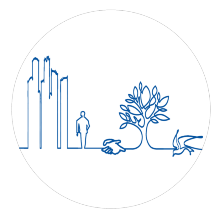1. evening: Urbane Bauphysik und Klimawandel
The opening event on February 2nd, 2021 under the topic URBANE BAUPHYSIK UND KLIMAWANDEL (Urban building physics and climate change) urged participants to tackle urban building physics and climate change at a political as well as a personal level. More than 140 listeners were given an overview of the contents and objectives of the dialog series. Through a multitude of questions from the audience following the input presentations, an exciting dialogue and exchange took place.
“There are a lot of ways to get active”, reminded Linda Meier, research assistant at the Institute for Acoustics and Building Physics (IABP) at the Faclty, when addressing her audience. What she means is the choices we can make to help combat climate change. The choice of whether to just set up a barbecue on the balcony or to plant some flowering herbs. The choice of whether to spend money on a new bathroom which you can see the benefits from now, or to invest in protecting the climate for the long term. The choice of whether to plant a tree in front of the façade of our home, and what type of tree and what position to plant it in.
Food for thought, exchange, solutions
These are just some of the issues which were discussed on the evening of 2 February, when Prof. Philip Leistner invited interested parties to the first of an online series of dialogs on the topic of climate-positive construction [de]. The invitation to the event billed it as “providing food for thought, proposing solutions, and encouraging exchange between different groups in a motivational way”. The interactive survey at the beginning of the event showed that more than a hundred people were in attendance, which included students but also a lot of people in employment in particular. Many were from Stuttgart, as well as a sizable contingent from across Baden-Württemberg and beyond. They considered themselves well-informed about climate change in general, as well as about its consequences. However, they were less well informed when it came to actual opportunities to take action. The online series, which runs until April and is also open to new members, focuses on exactly this issue.
Using climate-positive construction as a tool against the extinction of species and social inequalities
Leistner and members of academic staff at his institute – including Adrian Eitle and Pia Krause as well as Meier – list some specific ways people can take action. “There’s not a lack of knowledge, there’s a lack of action”, summarized Meier on the first evening, and used numbers and calculations to show what kind of measures were both necessary and possible to reduce CO2 emissions, and as a consequence for example preserve species which may otherwise be threatened with extinction. She also went on to say that climate positivity in construction clearly dovetails with social justice issues around the world. This naturally relates to the political sphere as well as the personal sphere. The results of this can already be seen in some of the measures taken by the University of Stuttgart. These were presented by David Kopp, who as well as giving us a student’s perspective as the Head of Sustainability at the Student Council stuvus also gave us a good overview of the University’s sustainability strategy.
You can find the presentations here:
- Prof. Dr.-Ing. Philip Leistner, director IABP: Welcome and survey [DE]
- Linda Meier, research assistant IABP: Zum lebenswerten Raum von morgen [DE] (To the livable space of tomorrow)
- David Kopp, Head of Sustainability at the Student Council stuvus: Nachhaltigkeit an der Universität Stuttgart [DE] (Sustainability ath teh University of Stuttgart)
2. evening: Menschen, Hitze und urbane Strukturen
On February 09th, 2021, the second event of the Dialog series BUILDING A CLIMATE POSITIVE FUTURE TOGETHER took place with the topic MENSCHEN, HITZE UND URBANE STRUKTUREN (People, heat and urban structures)
More than 100 listeners followed the event. The speakers gave an overview of the peculiarities of people's thermal sensation and heat stress in urban areas in the course of climate change. Building physics implications and measures to improve urban living and comfort were highlighted. Questions about subsidies, the state of the art as well as possibilities for renovation and climate change adaptation through e.g. blue-green infrastructures were taken up and diligently commented on.
You can find the presentations here:
- Prof. Dr.-Ing. Gunnar Grün, Professor IABP: Lebenswerte urbane Räume für Menschen [DE] (Liveable urban spaces for people)
- Benedikt Schwertel, Energy consultant, GIH BW: Energieberatung [DE] (Energy consulting)
- Philipp Alber, staff Ramboll Studio Dreiseitl: Ramboll Studio Dreiseitl [DE]
Further events: Take part!
With a great deal of commitment, the organizers have created a space for information and exchange. “It’s an open-ended experiment”, said Leistner, who said he could easily imagine that networks would be formed and initiatives created as a result of the online series.
- 2. März 2021, 19 Uhr: Soziale Gerechtigkeit (Social justice)
- 23. März 2021, 19 Uhr: Lebendige Strukturen in der gebauten Umwelt (Flora) (Living structures in the built environment (Flora).)
- 13. April 2021, 19 Uhr: Lebendige Strukturen in der gebauten Umwelt (Fauna) (Living structures in the built environment (Fauna).)


